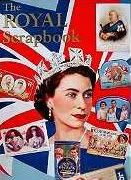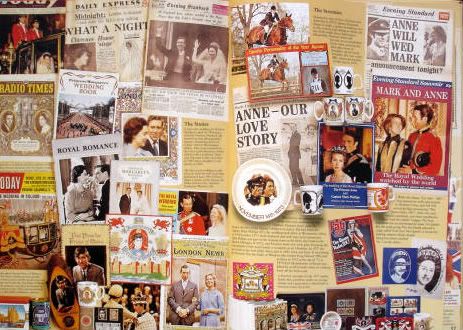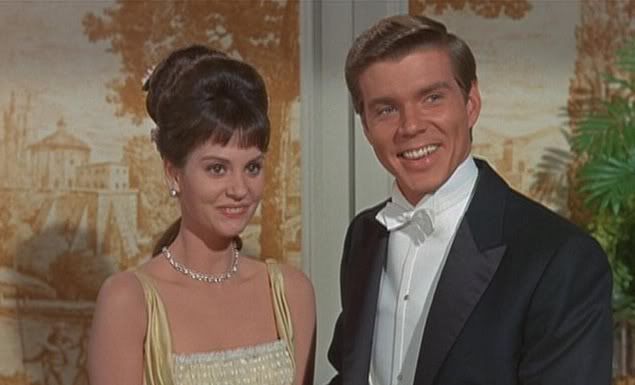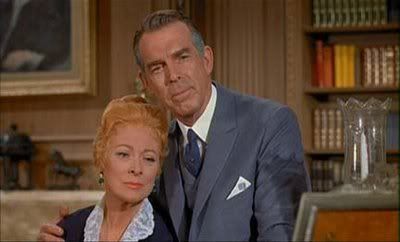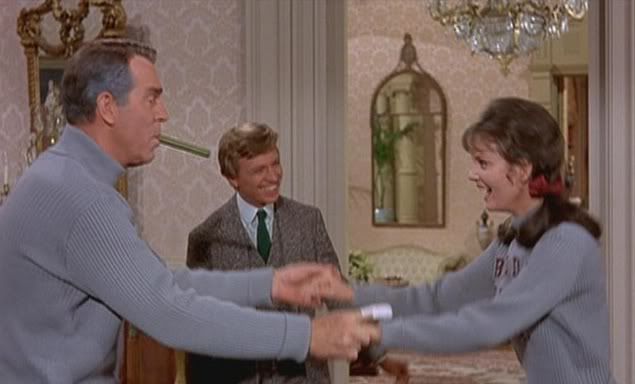 "The Happiest Millionaire" is another one of Disney's fantasmagorical musical extravagances. After having completed "Mary Poppins" in 1965, Walt Disney's enthusiasm for musical films was at an all-time high, and with the recently purchased rights to Cordelia Drexel Biddle's book/play in his hands he couldn't resist turning the story into a musical. And how fortunate that he did! With a 172 minute run-time ( Disney's lengthiest feature film to date ) it allowed for over 80 minutes of musical sequences ( 14 different songs ). Every principle player got to showcase their talent with a song and dance routine - many who never sang before!
"The Happiest Millionaire" is another one of Disney's fantasmagorical musical extravagances. After having completed "Mary Poppins" in 1965, Walt Disney's enthusiasm for musical films was at an all-time high, and with the recently purchased rights to Cordelia Drexel Biddle's book/play in his hands he couldn't resist turning the story into a musical. And how fortunate that he did! With a 172 minute run-time ( Disney's lengthiest feature film to date ) it allowed for over 80 minutes of musical sequences ( 14 different songs ). Every principle player got to showcase their talent with a song and dance routine - many who never sang before!
The film focuses on the family life of Anthony J. Drexel Biddle ( Fred MacMurray ), one of Philadelphia's most prominent citizens, albeit a bit eccentric... you see, he likes to keep alligators in the house ( the eldest, George, has a habit of escaping ) and he teaches boxing to students through his Biddle Bible Class. Within the walls of his ornate mansion resides a household of non-conformists; a beautiful family united in their belief that one should be true to oneself and not change to satisfy Society's expectations.
Before we meet the family, we are introduced to John Lawless ( Tommy Steele ), a newly arrived Irish immigrant, who obtains the not-so-coveted position of Biddle butler, and he becomes our on-and-off narrator throughout the movie.

After a brief appearence from the two sons ( Paul Peterson and Eddie Hodges ) performing the ' Watch Your Footwork' number, they are sent off the school and we see them no more. But this is where our heroine Cordy comes in ( the lovely Lesley Ann Warren ). She's reached the age of doubting whether being independently-minded is worth the price of being labeled a social outcast, for she's beginning to realize that boys do not like girls who can throw a left-hook. So naturally Cordy is enthralled at the idea of attending the finishing school her strait-laced Aunt Mary ( Gladys Cooper ) suggests she attend. While there she recieves instruction in the art of 'bye-yum pum-pum', that oh-so mysterio-so quality of making yourself alluring to me. But it seems that her first suitor Angie ( John Davidson ) finds her attempt at this laughable. In fact, he likes her just the way she is - different! Now isn't that how it always works out.
 Geraldine Page ) expects him to follow in his father's footsteps.
Geraldine Page ) expects him to follow in his father's footsteps.
And this is where we come to the basis of our film - to do or not to do. Hold on to your beliefs or follow what others tell you. Stick to your guns or bear the white flag. Yes, this is the underlying theme of the picture. If you are a Disney fan then the outcome is easy to guess, but just so there is an element of surprise left - I won't tell you.
BEHIND THE SCENES
"The Happiest Millionaire" opened in New York on November 20th, 1956, starring Walter Pidgeon. Kyle Crichton and Cordelia Drexel Biddle's play was based on her novel, 'My Philadelphia Father' published in 1955.
Shortly after the premiere of "Mary Poppins", work began on "The Happiest Millionaire", and many of the Poppins Production team were brought together again to work on this movie, including choreographers Marc Breaux and Dee Dee Wood, cinematographer Edward Colman, songwriters Richard and Robert Sherman, art director Carrol Clark and special effects maestro Peter Ellenshaw.
Having a tremendous budget with which to work with, the team freely used it : over 3,000 complete outfits were made for the production, valued at $250,000, and an entire replica of Biddle's Philadelphia mansion was built, filled with more than $450,000 worth of furnishings and antiques.
 When the film was released in theatres, close to 30 minutes of footage was cut; much of which was the overture, entracte, and closing credits. But one notable scene that was cut was the ending - Mr. and Mrs. Biddle ( Greer Garson ) are feeling down in spirit, now that their children are either married or away at school, and they sing the beautiful song, "It Won't Be Long 'Til Christmas". This was a lovely scene,so fortunately it ( and various other segments ) were reinstated in the DVD roadshow version released by Disney Studios.
When the film was released in theatres, close to 30 minutes of footage was cut; much of which was the overture, entracte, and closing credits. But one notable scene that was cut was the ending - Mr. and Mrs. Biddle ( Greer Garson ) are feeling down in spirit, now that their children are either married or away at school, and they sing the beautiful song, "It Won't Be Long 'Til Christmas". This was a lovely scene,so fortunately it ( and various other segments ) were reinstated in the DVD roadshow version released by Disney Studios. "The Happiest Millionaire" is a bit long for one sitting, so I'd spread it out over two nights, but it is such as charming movie... colorful sets and costumes, lively tunes, bravado performances by talented actors, and an air of "fortuosity" hovers throughout it all. The movie also holds the significance of being the last live-action film Walt Disney saw completed before his death.
If you have the opportunity to see "The Happiest Millionaire" then by all means do so. Regardless of what some critics say about it, I thoroughly enjoy watching this film... over... and over... and over again... and "What's wrong with that?"


